DIGITAL CAMERA
FINEPIX HS10
Owner’s Manual
Thank you for your purchase of this prod-
uct. This manual describes how to use
your FUJIFILM FinePix HS10 digital camera
and the supplied software. Be sure that
you have read and understood its con-
tents before using the camera.
For information on related products, visit our website at
http://www.fujifilm.com/products/digital_cameras/index.html
YF00623-120 EN
Before You Begin
First Steps
Basic Photography and Playback
More on Photography
More on Playback
Movies
Connections
Menus
Technical Notes
Troubleshooting
Appendix
�
For Your Safety
• Read Instructions: All the safety and
operating instructions should be
read before the appliance is oper-
ated.
• Retain Instructions: The safety and
operating instructions should be
retained for future reference.
• Heed Warnings: All warnings on the
appliance and in the operating in-
structions should be adhered to.
• Follow Instructions: All operating
and use instructions should be fol-
lowed.
Installation
Installation
Power Sources: This video product
should be operated only from the
type of power source indicated on
the marking label. If you are not sure
of the type of power supply to your
home, consult your appliance dealer
or local power company. For video
products intended to operate from
battery power, or other sources, refer
to the operating instructions.
Grounding or Polarization: This video
product is equipped with a polar-
ized alternating-current line plug (a
plug having one blade wider than
the other). This plug will fi t into the
power outlet only one way. This is a
safety feature. If you are unable to in-
sert the plug fully into the outlet, try
reversing the plug. If the plug should
still fail to fi t, contact your electrician
to replace your obsolete outlet. Do
ii
IMPORTANT SAFETY INSTRUCTIONS
This
not defeat the safety purpose of the
polarized plug.
Alternate Warnings:
video
product is equipped with a 3-wire
grounding-type plug, a plug having
a third (grounding) pin. This plug will
only fi t into a grounding-type power
outlet. This is a safety feature. If you
are unable to insert the plug into
the outlet, contact your electrician
to replace your obsolete outlet. Do
not defeat the safety purpose of the
grounding-type plug.
Overloading: Do not overload wall
outlets and extension cords as this
can result in a risk of fi re or electric
shock.
Ventilation: Slots and openings in the
cabinet are provided for ventilation
and to ensure reliable operation of
the video product and to protect it
from overheating, and these open-
ings must not be blocked or cov-
ered.
The openings should never be
blocked by placing the video prod-
uct on a bed, sofa, rug, or other simi-
lar surface.
This video product should not be
placed in a built-in installation such
as a bookcase or rack unless proper
ventilation is provided or the man-
ufacturer’s instructions have been
adhered to.
This video product should never be
placed near or over a radiator or heat
register.
Attachments: Do not use attachments
not recommended by the video
product manufacturer as they may
cause hazards.
Water and Moisture: Do not use this
video product near water – for ex-
ample, near a bath tub, wash bowl,
kitchen sink, or laundry tub, in a wet
basement, or near a swimming pool,
and the like.
Power-Cord Protection: Power-Sup-
ply cords should be routed so that
they are not likely to be walked on
or pinched by items placed upon
or against them, paying particular
attention to cords at plugs, conve-
nience receptacles, and the point
where they exit from the appliance.
Accessories: Do not place this video
product on an unstable cart, stand,
tripod, bracket, or table. The video
product may fall, causing serious in-
jury to a child or adult, and serious
damage to the appliance. Use only
with a cart, stand, tripod, bracket, or
table recommended by the manu-
facturer, or sold with the video prod-
uct. Any mounting of the appliance
should follow the manufacturer’s in-
structions, and should use a mount-
ing accessory recommended by the
manufacturer.
An
appliance
and cart com-
bination should
be moved with
care. Quick stops,
excessive
force,
and uneven sur-
faces may cause the appliance and
cart combination to overturn.
Antennas
Antennas
Outdoor Antenna Grounding:
If an
outside antenna or cable system is
connected to the video product, be
sure the antenna or cable system
is grounded so as to provide some
protection against voltage surges
and built-up static charges. Section
810 of the National Electrical Code,
ANSI/NFPA No. 70, provides informa-
tion with respect to proper grounding
of the mast and supporting struc-
ture, grounding of the lead-in wire
to an antenna-discharge unit, size of
grounding conductors,
location of
antenna-discharge unit, connection
to grounding electrodes, and require-
ments for the grounding electrode.
�
Power Lines: An outside antenna sys-
tem should not be located in the
vicinity of overhead power lines or
other electric light or power circuits,
or where it can fall into such power
lines or circuits. When installing an
outside antenna system, extreme
care should be taken to keep from
touching such power lines or circuits
as contact with them might be fatal.
EXAMPLE OF ANTENNA GROUNDING
AS PER NATIONAL ELECTRICAL CODE
Ground Clamp
Antenna
Lead in Wire
Electric
Service
Equipment
Ground
Clamps
Power Service
Grounding Electrode
System (NEC ART 250.
PART H)
Antenna
Discharge Unit
(NEC SECTION
810-20)
Grounding
Conductors
(NEC SECTION
810-21)
UseUse
Cleaning: Unplug this video product
from the wall outlet before clean-
ing. Do not use liquid cleaners or
aerosol cleaners. Use a damp cloth
for cleaning.
Object and Liquid Entry: Never push
objects of any kind into this video
product through openings as they
may
touch dangerous voltage
points or short out parts that could
result in a fi re or electric shock. Never
spill liquid of any kind on the video
product.
Lightning: For added protection for
this video product receiver during
a lightning storm, or when it is left
unattended and unused for long pe-
riods of time, unplug it from the wall
outlet and disconnect the antenna
or cable system. This will prevent
damage to the video product due to
lightning and power-line surges.
Service
Service
Servicing: Do not attempt to service
this video product yourself as open-
ing or removing covers may expose
you to dangerous voltage or other
hazards. Refer all servicing to quali-
fi ed service personnel.
Damage Requiring Service: Unplug this
video product from the wall outlet
and refer servicing to qualifi ed ser-
vice personnel under the following
conditions:
When the power-supply cord or
plug is damaged.
If liquid has been spilled, or objects
have fallen into the video product.
If the video product has been ex-
posed to rain or water.
If the video product has been
dropped or the cabinet has been
damaged.
If the video product does not op-
erate normally be following the
operating instructions. Adjust only
those controls that are covered by
the operating instructions as an im-
proper adjustment of other controls
may result in damage and will often
require extensive work by a qualifi ed
technician to restore the video prod-
uct to its normal operation.
When the video product exhibits a
distinct change in performance - this
indicates a need for service.
For Your Safety
Replacement Parts: When replace-
ment parts are required, be sure
the service technician has used
replacement parts specifi ed by the
manufacturer or have the same
characteristics as the original part.
Unauthorized
substitutions may
result in fi re, electric shock or other
hazards.
Safety Check: Upon completion of any
service or repairs to this video prod-
uct, ask the service technician to
perform safety checks to determine
that the video product is in proper
operating condition.
iii
�
Be sure to read this notes before using
Safety Notes
• Make sure that you use your camera correctly. Read these Safety Notes and
your Owner’s Manual carefully before use.
• After reading these Safety Notes, store them in a safe place.
About the Icons
The icons shown below are used in this document to indicate the severity of
the injury or damage that can result if the information indicated by the icon
is ignored and the product is used incorrectly as a result.
Do not use in
the bathroom
or shower.
This icon indicates that death or serious injury can result if the infor-
mation is ignored.
WARNING
Do not disas-
semble.
This icon indicates that personal injury or material damage can result
if the information is ignored.
CAUTION
The icons shown below are used to indicate the nature of the information
which is to be observed.
Triangular icons tell you that this information requires attention (“im-
portant”).
Circular icons with a diagonal bar tell you that the action indicated is
prohibited (“Prohibited”).
Filled circles with an exclamation mark tell you an action that must be
performed (“Required”).
WARNING
WARNING
If a problem arises, turn the camera off , remove the battery, disconnect and
unplug the AC power adapter.
Continued use of the camera when it is emitting smoke, is emitting
any unusual odor, or is in any other abnormal state can cause a fi re
or electric shock.
• Contact your FUJIFILM dealer.
Unplug
from power
socket.
For Your Safety
WARNING
WARNING
Do not allow water or foreign objects to enter the camera.
If water or foreign objects get inside the camera, turn the camera
off , remove the battery and disconnect and unplug the AC power
adapter.
Continued use of the camera can cause a fi re or electric shock.
• Contact your FUJIFILM dealer.
Do not use the camera in the bathroom or shower.
This can cause a fi re or electric shock.
Never attempt to change or take apart the camera. (Never open the casing.) Do
not use the camera when it has been dropped or the casing is damaged.
This can cause a fi re or electric shock.
• Contact your FUJIFILM dealer.
Do not change, heat or unduly twist or pull the connection cord and do not
place heavy objects on the connection cord.
These actions could damage the cord and cause a fi re or electric
shock.
• If the cord is damaged, contact your FUJIFILM dealer.
Do not place the camera on an unstable surface.
This can cause the camera to fall or tip over and cause injury.
Never attempt to take pictures while in motion.
Do not use the camera while you are walking or driving a vehicle. This
can result in you falling down or being involved in a traffi c accident.
Do not touch any metal parts of the camera during a thunderstorm.
This can cause an electric shock due to induced current from the
lightning discharge.
Do not use the battery except as specifi ed.
Load the battery as aligned with the indicator.
Do not heat, change or take apart the battery. Do not drop or subject the bat-
tery to impacts. Do not store the battery with metallic products. Do not use
chargers other than the specifi ed model to charge the battery.
Any of these actions can cause the battery to burst or leak and cause
fi re or injury as a result.
Use only the battery or AC power adapters specifi ed for use with this camera.
Do not use voltages other than the power supply voltage shown.
The use of other power sources can cause a fi re.
iv
�
WARNING
WARNING
If the battery leaks and fl uid gets in contact with your eyes, skin or clothing.
Flush the aff ected area with clean water and seek medical attention or call an
emergency number right away.
Do not use the charger to charge batteries other than those specifi ed here.
The Ni-MH battery charger is designed for Fujifi lm HR-AA Ni-MH bat-
teries. Using the charger to charge conventional batteries or other
types of rechargeable batteries can cause the battery to leak fl uid,
overheat or burst.
When carrying the battery, install it in a digital camera or keep it in the hard
case. When storing the battery, keep it in the hard case. When discarding,
cover the battery terminals with insulation tape.
Contact with other metallic objects or battery could cause the bat-
tery to ignite or burst.
Keep Memory Cards out of the reach of small children.
Because Memory Cards are small, they can be swallowed by children.
Be sure to store Memory Cards out of the reach of small children. If
a child swallows a Memory Card, seek medical attention or call an
emergency number.
CAUTION
CAUTION
Do not use this camera in locations aff ected by oil fumes, steam, humidity or
dust.
This can cause a fi re or electric shock.
Do not leave this camera in places subject to extremely high temperatures.
Do not leave the camera in locations such as a sealed vehicle or in
direct sunlight. This can cause a fi re.
Keep out of the reach of small children.
This product could cause injury in the hands of a child.
Do not place heavy objects on the camera.
This can cause the heavy object to tip over or fall and cause injury.
Do not move the camera while the AC power adapter is still connected. Do not
pull on the connection cord to disconnect the AC power adapter.
This can damage the power cord or cables and cause a fi re or electric
shock.
For Your Safety
CAUTION
CAUTION
Do not use the AC power adapter when the plug is damaged or the plug socket
connection is loose.
This could cause a fi re or electric shock.
Do not cover or wrap the camera or the AC power adapter in a cloth or blanket.
This can cause heat to build up and distort the casing or cause a fi re.
When you are cleaning the camera or you do not plan to use the camera for
an extended period, remove the battery and disconnect and unplug the AC
power adapter.
Failure to do so can cause a fi re or electric shock.
When charging ends, unplug the charger from the power socket.
Leaving the charger plugged into the power socket can cause a fi re.
Using a fl ash too close to a person’s eyes may temporarily aff ect the eyesight.
Take particular care when photographing infants and young chil-
dren.
When an xD-Picture Card is removed, the card could come out of the slot too
quickly. Use your fi nger to hold it and gently release the card.
Request regular internal testing and cleaning for your camera.
Build-up of dust in your camera can cause a fi re or electric shock.
• Contact your FUJIFILM dealer to request internal cleaning every 2
years.
• Please note this is not a free of charge service.
v
�
Power Supply and Battery
* Confirm your battery type before read-
ing the following descriptions.
The following explains proper use of
batteries and how to prolong their
life. Incorrect use of batteries can
cause shorter battery life, as well as
leakage, excessive heat, fi re or explo-
sion.
1 Camera uses the Rechargeable
Lithium-ion Battery
* When shipped, the battery is not
fully charged. Always charge the
battery before using it.
* When carrying the battery, install it
in a digital camera or keep it in the
soft case.
■ Battery Features
• The battery gradually
its
charge even when not used. Use
a battery that has been charged
recently (in the last day or two) to
take pictures.
loses
• To maximize the life of the battery,
turn the camera off as quickly as
possible when it is not being used.
• The number of available frames will
be lower in cold locations or at low
temperatures. Take along a spare
fully charged battery. You can also
increase the amount of power pro-
duced by putting the battery in
your pocket or another warm place
to heat it and then loading it into
the camera just before you take a
picture.
vi
For Your Safety
If you are using a heating pad, take
care not to place the battery di-
rectly against the pad. The camera
may not operate if you use a de-
pleted battery in cold conditions.
■ Charging the Battery
• You can charge the battery using
the battery charger (included).
- The battery can be charged
at ambient temperatures be-
tween 0°C and +40°C (+32°F
and +104°F). Refer to the Owner’s
Manual for the time of charging
battery.
- You should charge the battery
at an ambient temperature be-
tween +10°C and +35°C (+50°F
and +95°F). If you charge the
battery at a temperature outside
this range, charging takes longer
because the performance of the
battery is impaired.
- You cannot charge the battery
at temperatures of 0°C (+32°F) or
below.
• The Rechargeable Lithium-ion Bat-
tery does not need to be fully dis-
charged or exhausted fl at before
being charged.
• The battery may feel warm after it
has been charged or immediately
after being used. This is perfectly
normal.
• Do not recharge a fully charged
battery.
■ Battery Life
At normal temperatures, the bat-
tery can be used at least 300 times.
If the time for which the battery
provides power shortens markedly,
this indicates that the battery has
reached the end of its eff ective life
and should be replaced.
■ Notes on storage
• If a battery is stored for long periods
while charged, the performance of
the battery can be impaired. If the
battery will not be used for some
time, run the battery out before
storing it.
• If you do not intend to use the
camera for a long period of time,
remove the battery from the cam-
era.
• Store the battery in a cool place.
- The battery should be stored in
a dry location with an ambient
temperature between +15°C and
+25°C (+59°F and +77°F).
- Do not leave the battery in hot or
extremely cold places.
■ Handling the Battery
Cautions for Your Safety:
• Do not carry or store battery with
metal objects such as necklaces or
hairpins.
• Do not heat the battery or throw it
into a fi re.
• Do not attempt to take apart or
change the battery.
• Do not recharge the battery with
chargers other those specifi ed.
• Dispose of used battery promptly.
• Do not drop the battery or other-
wise subject it to strong impacts.
• Do not expose the battery to wa-
ter.
• Always keep the battery terminals
clean.
• Do not store batteries in hot plac-
es. Also, if you use the battery for
a long period, the camera body
and the battery itself will become
warm. This is normal. Use the AC
power adapter if you are taking
pictures or viewing images for a
long period of time.
2 Camera uses AA-size alkaline or Ni-MH
(nickel-metal hydride) rechargeable
batteries
* For details on the batteries that
you can use, refer to the Owner’s
Manual of your camera.
■ Cautions for Using Battery
• Do not heat the batteries or throw
them into a fi re.
• Do not carry or store batteries with
metal objects such as necklaces or
hairpins.
• Do not expose the batteries to wa-
ter, and keep batteries from getting
wet or stored in moist locations.
• Do not attempt to take apart or
including
change the batteries,
battery casings.
• Do not subject the batteries to
strong impacts.
• Do not use batteries that are leak-
ing, deformed, discolored.
�
• Do not store batteries in warm or
humid places.
• Keep the batteries out of reach of
babies and small children.
• Make sure that the battery polarity
(C and D) is correct.
• Do not use new with used batter-
ies. Do not use charged and dis-
charged batteries together.
• Do not use diff erent types or
brands of batteries at the same
time.
• If you do not intend to use the
camera for a long period of time,
remove the batteries from the
camera. Note if the camera is left
with the batteries removed, the
time and date settings are cleared.
• The batteries feel warm right af-
ter being used. Before removing
the batteries, turn the camera off
and wait for the batteries to cool
down.
• Since batteries do not work well in
cold weather or locations, warm
the batteries by placing them in-
side your garments before use.
Batteries do not work well when
cold. They will work again when
the temperature returns to normal.
• Soil (such as fi ngerprints) on the
battery terminals makes the bat-
teries charge
less reducing the
number of images. Carefully wipe
the battery terminals with a soft
dry cloth before loading.
If any liquid at all leaks from
the batteries, wipe the battery
compartment thoroughly and
then load new batteries.
If any battery fl uid comes into
contact with your hands or
clothing, fl ush the area thor-
oughly with water. Note that
battery fl uid can cause loss
of eyesight if it gets into your
eyes. If this occurs, do not rub
your eyes. Flush the fl uid out
with clean water and contact
your physician for treatment.
■ Using the AA-size Ni-MH batteries
correctly
left unused
• Ni-MH batteries
in
storage for long periods can be-
come “deactivated”. Also, repeat-
edly charging Ni-MH batteries
that are only partially discharged
can cause them to suff er from the
“memory eff ect”. Ni-MH batteries
that are “deactivated” or aff ected
by “memory” suff er from the prob-
lem of only providing power for a
short time after being charged. To
prevent this problem, discharge
and recharge them several times
using the camera’s “Discharging
rechargeable batteries” function.
Deactivation and memory are spe-
cifi c to Ni-MH batteries and are not
in fact battery faults.
See Owner’s Manual for the proce-
dure for “Discharging rechargeable
batteries”.
CAUTION
CAUTION
Do not use the “Discharging re-
chargeable batteries” function when
alkaline batteries being used.
• To charge Ni-MH batteries, use the
quick battery charger (sold sepa-
rately). Refer to the instructions
supplied with the charger to make
sure that the charger is used cor-
rectly.
• Do not use the battery charger to
charge other batteries.
• Note that the batteries feel warm
after being charged.
• Due to the way the camera is con-
structed, a small amount of current
is used even when the camera is
turned off . Note in particular that
leaving Ni-MH batteries
in the
camera for a long period will over-
discharge the batteries and may
render them unusable even after
recharging.
• Ni-MH batteries will self-discharge
even when not used, and the time
for which they can be used may be
shortened as a result.
if over-discharged
• Ni-MH batteries will deteriorate
rapidly
(e.g.
by discharging the batteries in a
fl ashlight). Use the “Discharging re-
chargeable batteries” function pro-
vided in the camera to discharge
the batteries.
For Your Safety
• Ni-MH batteries have a
limited
service life. If a battery can only
be used for a short time even after
repeated discharge-charge cycles,
it may have reached the end of its
service life.
■ Disposing of Batteries
• When disposing of batteries, do
so in accordance with your local
waste disposal regulations.
3 Notes on both models ( 1 , 2 )
■ AC Power Adapter
Always use the AC Power Adapter
with the camera. The use of an AC
Power adapter other than FUJIFILM
AC Power Adapter can be damaged
to your digital camera.
For details on the AC power adapter,
refer to the Owner’s Manual of your
camera.
• Use the AC power adapter for in-
door use only.
• Plug the connection cord plug se-
curely into the DC input terminal.
• Turn off the FUJIFILM Digital cam-
era before disconnecting the cord
from the DC input terminal. To dis-
connect, pull out the plug gently.
Do not pull on the cord.
• Do not use the AC power adapter
with any device other than your
camera.
• During use, the AC power adapter
will become hot to the touch. This
is normal.
vii
�
For Your Safety
■ Explanation of Color Television
System
NTSC: National Television System
Committee, color television
telecasting
specifi cations
adopted mainly in the U.S.A.,
Canada and Japan.
Phase Alternation by Line, a
color television system ad-
opted mainly by European
countries and China.
PAL:
■ Exif Print (Exif ver. 2.2)
Exif Print Format is a newly revised
digital camera fi le format that con-
tains a variety of shooting informa-
tion for optimal printing.
• Macintosh, QuickTime, and Mac OS
are trademarks of Apple Inc. in the
U.S.A. and other countries.
• Windows 7, Windows Vista and the
Windows logo are trademarks of
the Microsoft group of companies.
• IrSimple™ Trademark is owned by
the Infrared Data Association®.
• IrSS™ Trademark or IrSimpleShot™
Trademark is owned by the Infra-
red Data Association®.
• SDHC logo is a trademark.
• HDMI logo is a trademark.
• YouTube is a trademark of Google
Inc.
• Other company or product names
are trademarks or registered trade-
marks of the respective compa-
nies.
■ Notes on Electrical Interference
If the camera is to be used in hos-
pitals or aircrafts, please note that
this camera may cause interference
to other equipment in the hospital
or aircraft. For details, please check
with the applicable regulations.
• Do not take apart the AC power
adapter. Doing so could be dan-
gerous.
• Do not use the AC power adapter
in a hot and humid place.
• Do not subject the AC power
adapter to strong shocks.
• The AC power adapter may emit a
humming. This is normal.
• If used near a radio, the AC power
adapter may cause static. If this
happens, move the camera away
from the radio.
Before Using the Camera
■ Test Shots Prior to Photography
For important photographs (such as
weddings and overseas trips), always
take a test shot and view the im-
age to make sure that the camera is
working normally.
• FUJIFILM Corporation cannot ac-
cept
incidental
losses (such as the costs of photog-
raphy or the loss of income from
photography) incurred as a result
of faults with this product.
liability for any
■ Notes on Copyright
Images recorded using your digital
camera system cannot be used in
ways that infringe copyright laws
without the consent of the owner,
unless intended only for personal
use. Note that some restrictions ap-
ply to the photographing of stage
performances, entertainments and
exhibits, even when intended purely
for personal use. Users are also asked
to note that the transfer of Memory
Card containing images or data pro-
tected under copyright laws is only
permissible within the restrictions
imposed by those copyright laws.
■ Handling Your Digital Camera
To ensure that images are recorded
correctly, do not subject the camera
to impact or shock while an image is
being recorded.
■ Liquid Crystal
If the LCD monitor is damaged, take
particular care with the liquid crystal
in the monitor. If any of the follow-
ing situations arise, take the urgent
action indicated.
• If liquid crystal comes in contact
with your skin:
Wipe the area with a cloth and
then wash thoroughly with soap
and running water.
• If liquid crystal gets into your eye:
Flush the aff ected eye with clean
water for at least 15 minutes and
then seek medical assistance.
• If liquid crystal is swallowed:
Flush your mouth thoroughly with
water. Drink large quantities of wa-
ter and induce vomiting. Then seek
medical assistance.
■ Trademark Information
• E and xD-Picture Card™ are
trademarks of FUJIFILM Corpora-
tion.
• IBM PC/AT is a registered trademark
of International Business Machines
Corp. of the U.S.A.
viii
�
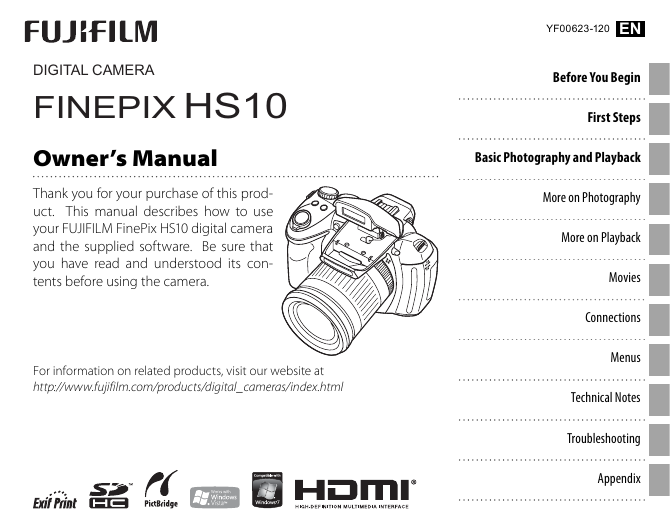
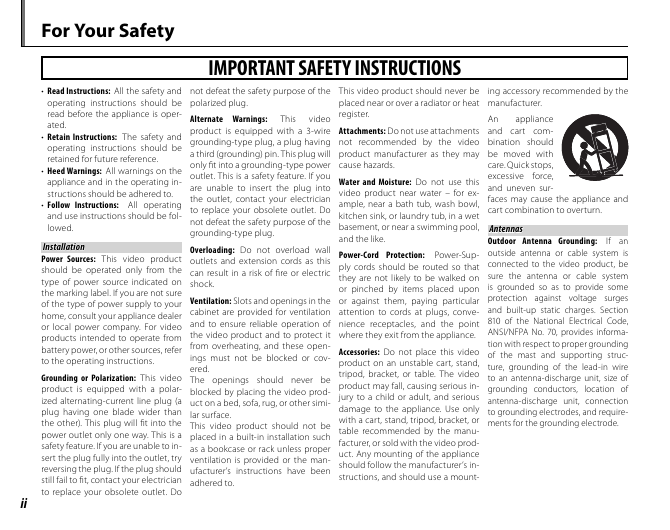
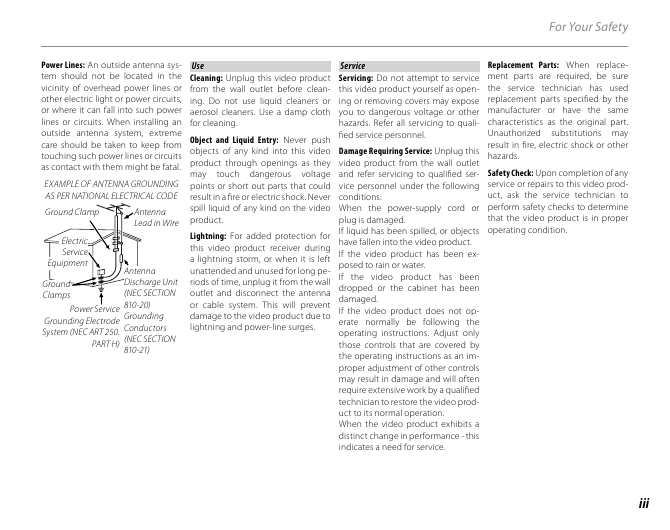
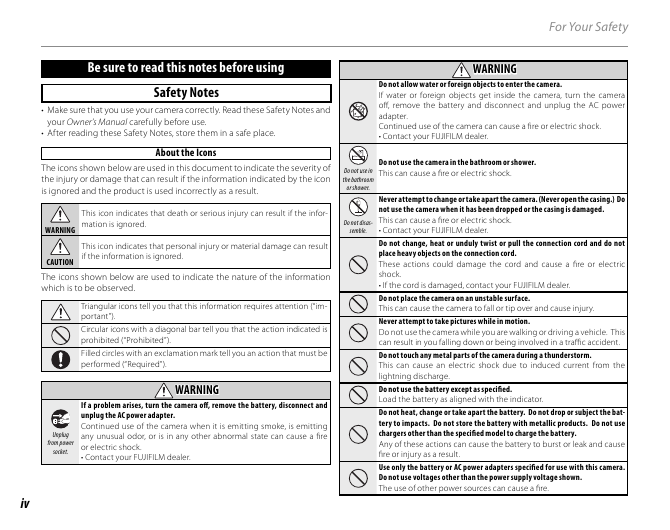
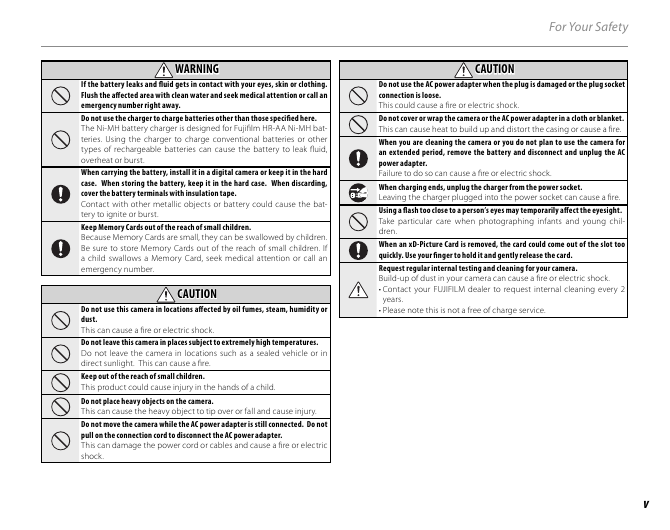
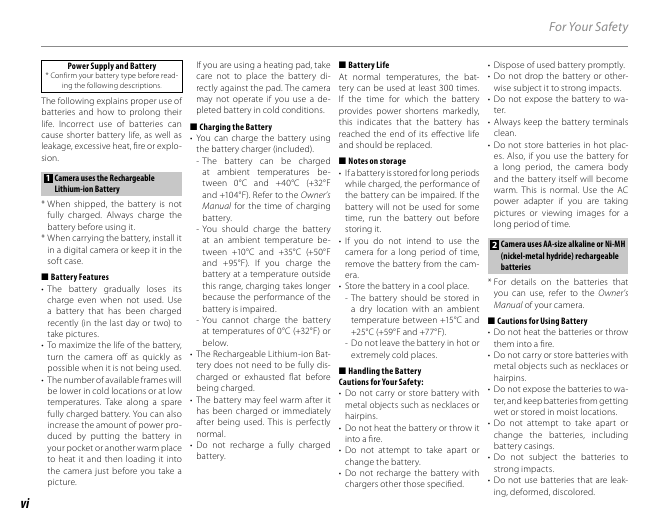
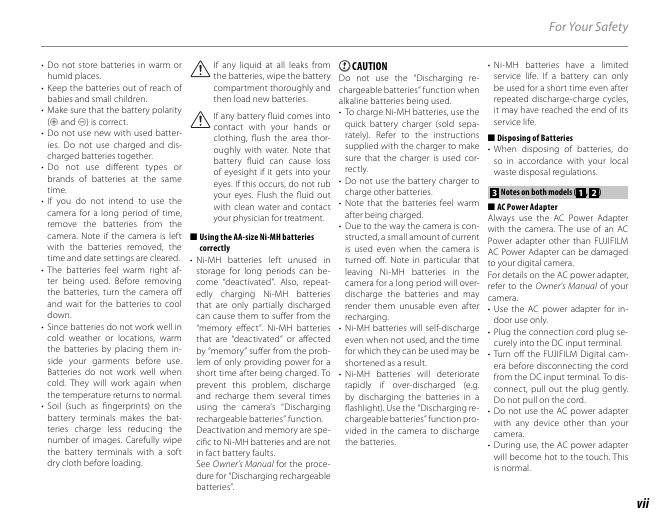
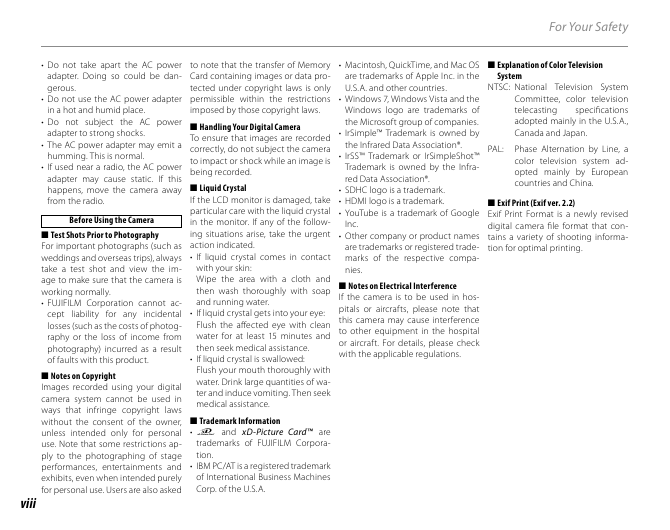








 2023年江西萍乡中考道德与法治真题及答案.doc
2023年江西萍乡中考道德与法治真题及答案.doc 2012年重庆南川中考生物真题及答案.doc
2012年重庆南川中考生物真题及答案.doc 2013年江西师范大学地理学综合及文艺理论基础考研真题.doc
2013年江西师范大学地理学综合及文艺理论基础考研真题.doc 2020年四川甘孜小升初语文真题及答案I卷.doc
2020年四川甘孜小升初语文真题及答案I卷.doc 2020年注册岩土工程师专业基础考试真题及答案.doc
2020年注册岩土工程师专业基础考试真题及答案.doc 2023-2024学年福建省厦门市九年级上学期数学月考试题及答案.doc
2023-2024学年福建省厦门市九年级上学期数学月考试题及答案.doc 2021-2022学年辽宁省沈阳市大东区九年级上学期语文期末试题及答案.doc
2021-2022学年辽宁省沈阳市大东区九年级上学期语文期末试题及答案.doc 2022-2023学年北京东城区初三第一学期物理期末试卷及答案.doc
2022-2023学年北京东城区初三第一学期物理期末试卷及答案.doc 2018上半年江西教师资格初中地理学科知识与教学能力真题及答案.doc
2018上半年江西教师资格初中地理学科知识与教学能力真题及答案.doc 2012年河北国家公务员申论考试真题及答案-省级.doc
2012年河北国家公务员申论考试真题及答案-省级.doc 2020-2021学年江苏省扬州市江都区邵樊片九年级上学期数学第一次质量检测试题及答案.doc
2020-2021学年江苏省扬州市江都区邵樊片九年级上学期数学第一次质量检测试题及答案.doc 2022下半年黑龙江教师资格证中学综合素质真题及答案.doc
2022下半年黑龙江教师资格证中学综合素质真题及答案.doc